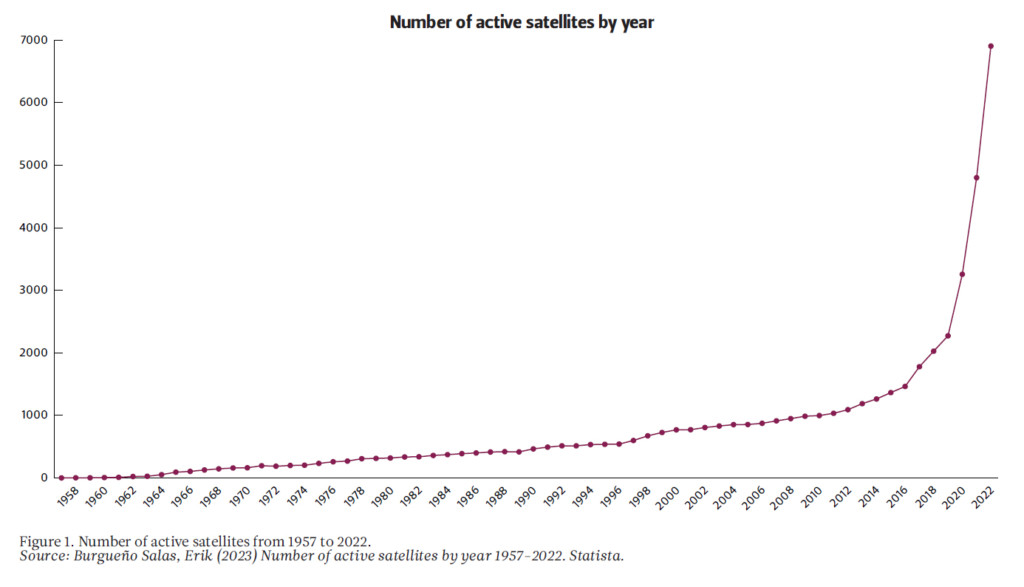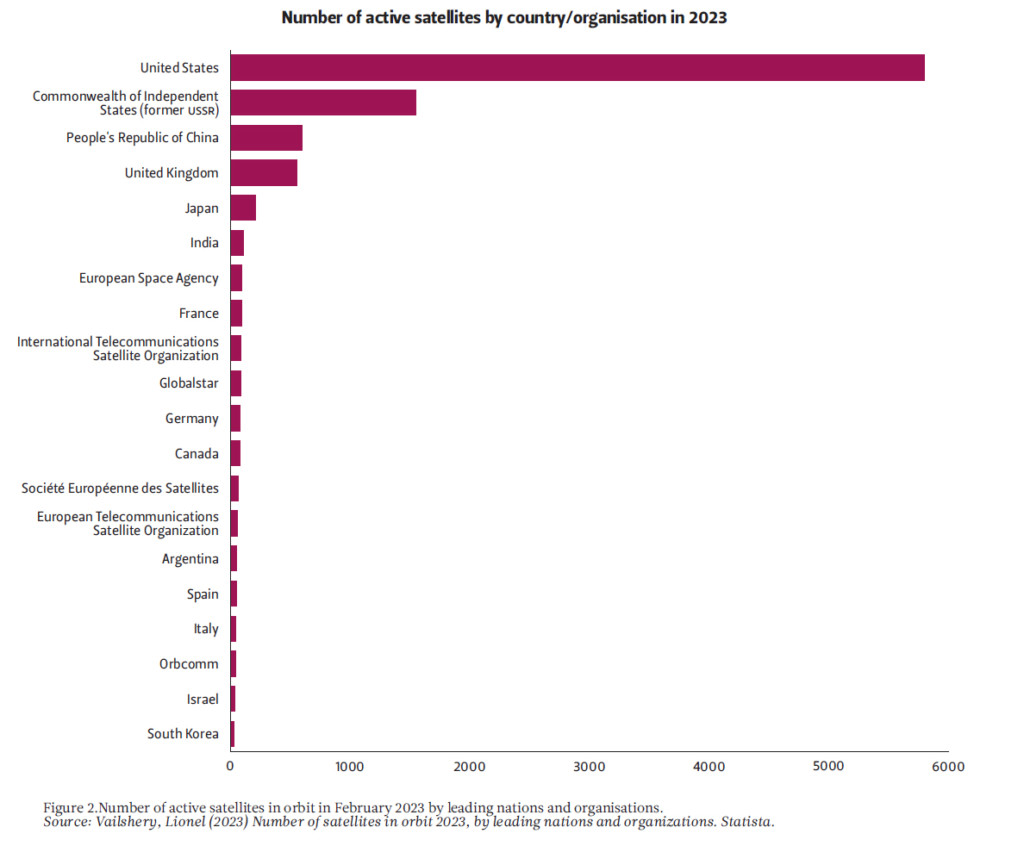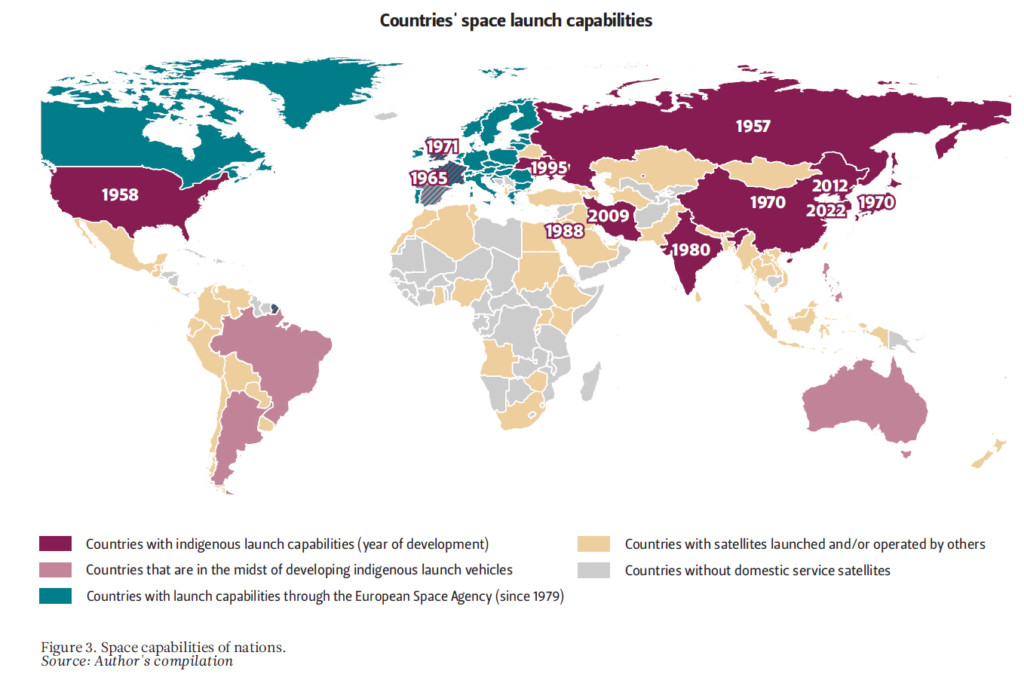yhteenveto
Avaruusalan toiminta lisääntyy tällä hetkellä nopeasti. Avaruusteknologioista ja ‑palveluista on tulossa yhä tärkeämpiä, mikä ruokkii alan kasvua entisestään.
Monilla avaruusteknologioilla on kriittisiä käyttötarkoituksia sekä sotilaallisessa toiminnassa että siviilialoilla. Nämä ovat enenevissä määrin riippuvaisia yksityissektorista.
Avaruussektorin merkityksen kasvaessa myös avaruusinfrastruktuuria vastaan kohdennetut kyberoperaatiot yleistyvät. Tämän seurauksena on yhä vaikeampaa attribuoida kyberhyökkäyksiä eli nimetä ja saattaa vastuuseen niiden tekijöitä.
Yhdysvaltojen johtoasema avaruussektorilla vahvistuu nyt vauhdilla. Yhdysvaltalaisen SpaceX-yrityksen satelliitti-internetjärjestelmä Starlink sitoo monia valtioita jälleen yhteen Yhdysvaltojen hallinnoimaan tietoliikennearkkitehtuuriin.
Avaruusteknologioilla on huomattava vaikutus valtioiden kokonaisturvallisuuteen, minkä vuoksi niihin liittyvän kriisinsietokyvyn kehittäminen on tärkeää. Valtioiden täytyy hajauttaa avaruuteen liittyvien palveluiden hankintaa ja samalla tiivistää yhteistyötä samanmielisten valtioiden kanssa.
Introduction
The space sector is experiencing a boom. Countries and companies around the world are currently investing heavily in space-related activities and technology. Investments in satellite technology, for example, are expected to increase drastically in the coming years, as space-reliant technologies and services become more and more important for individuals, corporations, and states.
TV programmes, online delivery services, public transportation applications, weather forecasts, traffic control systems, and electronic financial services, including card payments, are all examples of common services critically reliant on space technologies.
Increasing dependence on space technologies for the functioning of such vital services and critical infrastructure implies a risk for those states that do not possess and control them. Conversely, states that do can leverage them for power political purposes.
In addition to their value for modern societies and power political competition, space technologies are also increasingly important in warfare. This has been clearly illustrated by the critical role played by satellite technology for Ukraine’s defence against Russia’s military aggression. The conflict also illustrates the extent to which militarily critical space infrastructure is being owned by the private sector, thus blurring the distinction between the civilian and military sectors and targets.
Between peacetime contestation for strategic advantage and open warfare, states also utilise and target space technologies for hybrid operations, such as cyber sabotage and espionage. These operations can support both peace- and wartime aims.
Building space resilience has therefore become paramount for states. However, most countries are unable to accomplish this alone, highlighting the need for cooperation both between states and with the private sector.
This Briefing Paper analyses strategic contestation in space. It focuses on the ways in which space technologies can serve as an instrument of power and calls attention to the reasons why the strengthening of space resilience is duly vital. The paper begins with an overview of space capabilities in the world, followed by a power political analysis, which is divided into three sections: the role of space technology for open warfare, hybrid operations, and strategic competition in peacetime. The paper then discusses the options that states have for building resilience against adversarial pressures outlined in the earlier sections. The paper concludes with a brief look at the future trajectory of international relations in space.
Space capabilities in the world
Since the beginning of the Space Age in the late 1950s, the global space sector has experienced exponential growth, witnessing an unprecedented surge in recent years in particular. For example, between 2017 and 2022,[1] the total number of operational satellites grew by over 5,000 satellites, as illustrated in Figure 1.

The increase in capabilities has been far from even between nations. As indicated in Figure 2, at the current stage, the United States has an unquestionable lead. While satellites have become smaller and lighter, the greatest advances have been made in rocketry. In particular, the partially reusable Falcon 9 rockets by US-based company SpaceX have been transformational, as illustrated by the fact that in 2022, SpaceX deployed more satellites than the rest of the world combined. As a result, the decline of US hegemony in the space domain has been reversed, and the space sector is booming everywhere.

Importantly, an increasing number of countries and companies have been able to afford SpaceX’s launch services without creating lasting dependencies because maintenance can be purchased elsewhere if need be. Thus, countries that also have older generation indigenous launch capabilities (marked in dark pink in Figure 3), or reliable access to such (marked in blue), have been the biggest beneficiaries after the US.

Countries with no existing satellite systems or launch capabilities (marked in grey) are unable to project any power in the space domain but may have services like a national broadcast or weather forecast, operated by someone else. As the space sector grows, an increasing number of countries can afford to purchase launch services or to rent satellites, as countries marked in yellow have done. As a result, as the space sector booms, new opportunities appear, but at the same time, the gap in capabilities between the strongest and the weakest nations grows. This gap between nations also underscores the importance of understanding and preparing for the increasing importance of the space domain in international contestation and competition.
The role of space technologies in warfare
The ability to use space technologies in conjunction with conventional forces is a requirement for modern warfare.[2] At the same time, almost all militarily critical space technologies also have vital civilian functions. The Global Positioning System, or GPS, is a good example. Operated by the United States Space Force, GPS not only provides navigation support and targeting assistance for combat missions, but also enables geolocation services in cellular phones, facilitates emergency services during disasters, and upholds exact time management on which international financial traffic critically relies.[3]
The projection of military power across vast distances at speeds required by modern warfare emphasises the need for satellite-assisted communication, command and control capabilities. These capabilities are partially in civilian hands, and even those technological architectures that are fully under military control utilise components and software developed by the civilian sector. Often cyber security and maintenance services are also provided by private contractors.
The resulting uncertainty further blurs the distinction between civil and military technologies. An illustrative example is the crucial involvement of SpaceX and Microsoft in the defence of Ukraine by providing internet access at the front for the first time in history, and by defending their own systems and thus Ukraine’s communication capabilities.
Ukraine’s example also shows the importance of both top-down and bottom-up information flows in modern military organisational command. Modern wars favour smaller units with the ability to seize the initiative and react independently when needed, while remaining able to receive and follow orders. The old communications and command system reliant on temporal cables and large communication centres is ill-suited for this. Instead, modern warfare requires direct data connections to a growing number of soldiers and systems, which necessitates civilian systems. Space infrastructure also remains vulnerable to conventional operations.
The major powers are increasingly investing in the development of ground-to-space capabilities. The United States, China, India, and Russia have all demonstrated capabilities for using anti-satellite missiles, although in practice any state capable of orbital launches has the technical ability to develop and deploy them. The major powers are also leading the development of new anti-satellite solutions. For example, terrestrial systems, such as lasers mounted on aeroplanes designed to damage satellites without creating debris, will soon be in operational use.
Space-to-ground and space-to-space weapons have been slower to develop, but as the relative importance of the space domain grows, the likelihood of warfare escalating to space increases. Luckily there are inhibiting factors currently reducing this likelihood.
Firstly, any kinetic strike (by a missile, for example) against orbital targets will cause large amounts of debris that is likely to also destroy the attacker’s own infrastructure. In addition, kinetic strikes near early warning satellites designed to detect nuclear warhead launches risk damaging these, which could be taken as a prelude to a nuclear strike. Kinetic space strikes are therefore a high-risk endeavour.
Secondly, as the role of space-to-ground and space-to-space operations has so far been limited, the need to develop these capabilities has been similarly restricted. As far as major powers develop these capabilities, they do so largely in secret, slowing down the pace of development.
Thirdly, taking warfare into space is expensive to the extent that even major powers have been hesitant to engage in developing such capabilities to a fuller extent.
Fourthly, states have demonstrated some willingness to limit a possible arms race in space by means of agreement. A total of 107 states have ratified The Outer Space Treaty of 1967, which prohibits the placing of weapons of mass destruction in space. However, the agreement does not prohibit orbital bombardment, which would be massively destructive. The lack of an effective enforcement mechanism behind the agreement also makes it weak. In addition, the treaty only refers to states, leaving private corporations outside its scope of regulation. Moreover, rules for resolving disputed claims in space are yet to be written.
The role of space technologies in hybrid operations
Space is also increasingly utilised in a pre-emptive manner in power political contestation, blurring the distinction between war and peace. This is partly a consequence of the security dilemma – a logic which pushes great powers towards matching each other’s capabilities – and partly because new technologies open new avenues for international contestation.
To begin with, it is important to note that space is an increasingly challenging domain for conducting (traditional) covert operations because it offers little in the way of natural cover. A covert sabotage operation, akin to the operation against the Nord Stream 2 pipeline at the bottom of the Baltic Sea in September 2022, is therefore immensely more difficult to pull off in the Earth’s orbit. For this reason, digital means dominate in space-related hybrid operations.
Digital means can be used to deny an adversary access to their space assets. The ability to do so often requires pre-existing access to the digital systems and a thorough understanding of the adversary’s digital landscape, including both hardware and software. Systems that are connected to the internet can be breached remotely, whereas those that are not require human operators to do so physically. States have more capabilities for such operations, which creates a critical difference compared to private operators.
However, offensive cyber operations that rely on internet connections are increasingly conducted by private and semi-private actors. Such obfuscation makes it difficult to name state actors as responsible for cyberattacks. Furthermore, the process of technically identifying a perpetrator of a cyber operation, also known as cyber attribution, can take months after an operation, or fail altogether, which makes deterrence by punishment hard. When the attacker’s associations are unclear, retaliation is even more difficult, which is a reason for states to favour private contractors. As such, deterrence by denial strategies (increasing costs rather than threatening with retaliation) are likely to gain relative importance. Yet creating deterrence of any kind without revealing one’s own capabilities and pre-emptively gained access remains a pervasive challenge in the digital domain.
The role of space technologies in strategic competition
Space is also increasingly important for strategic purposes in peacetime competition between major powers. Attempts to indirectly use space technologies to derive relative advantages include competing to gain first-mover advantage, using access and dependency asymmetries, and learning from those ahead.
First-mover advantage applies in many ways to both public and private sector operators. In markets where supply is finite, the price of entry naturally increases for latecomers. In addition to skilled human labour, which is in short supply in every tech sector, heavily competed finite assets in the space sector include favourable orbits, frequencies, and ground stations.
The UN-based International Telecommunication Union (ITU) assigns orbital spot allotments. Even though many states have not been able to put their own satellites up, the geostationary orbit has become saturated due to over-filing by space capable states, thereby foreclosing latecomers from achieving access.[4]
Frequency allotments in turn are controlled by the Master International Frequency Register (MIFR), but the most favoured frequencies are also traded with interested parties at high prices, which makes each successive entry to frequency markets more expensive and more exclusive.
Favourable ground stations are less constraining in absolute terms, but as space activity is booming, the cost of ground-station services increases rapidly. The location of a ground station is significant as it determines the quality of services that the station is able to provide, as well as the jurisdiction under which the station operates and the espionage operators who have a home-field advantage. Industrial espionage plays a crucial role in catching up with tech leaders.
Public and private tech leaders in turn have an upper hand that helps them to stay ahead of latecomers. Innovations based on newer technologies tend to be more valuable than those based on older solutions.
Tech leaders also have another advantage in the form of establishing norms. As formal regulations are necessarily introduced after new technologies are invented, new technologies themselves tend to set standards and protocols. Challenging established standards is often difficult because many subproducts and services may have already started to use the initial set, thus creating legacy dependencies.
Once in a position of asymmetric advantage, states can use it to bind other states to their sphere of influence for later strategic use. This can be done, for example, by offering inducements to start using particular technologies, standards or protocols. Lock-in effects in particular – being dependent on a service that cannot be fixed by switching to another vendor without significant costs – are prominent in the space sector because of the costs and technological difficulties involved.
As discussed earlier in this paper, the ability to provide space services to other nations is not evenly distributed between different countries and organisations. Instead, the US holds an unquestionable leading position, largely due to investments in SpaceX. Given the significant advantages its architecture offers, many states will find it difficult to avoid tying themselves to SpaceX’s Starlink communication satellite (comsat) constellation. For example, Starlink can offer a reliable internet connection to remote locations without requiring new infrastructure to be built. In addition, the very low orbital altitude of the constellation allows for using a multitude of portable terrestrial broadcast transmitters instead of the large towers that older comsats require. This means that critical transmissions can be hidden in mass and that destroying all receptors is virtually impossible. This obviously has transformational military implications as well. Similarly, it is more difficult to destroy or disrupt a large constellation of small and quickly replaceable satellites than large and often individually operated last generation comsats.
However, leveraging asymmetric dependencies in an adverse manner creates incentives for others to manage or get rid of those dependencies, which then induces a counterreaction and so on. An example of this tendency in action is the recent upsurge in decoupling measures and reshoring initiatives around the world.[5]
Building space resilience
For the purposes of this paper, space resilience refers to the state of having the physical, legislative, and intellectual capability to adapt effectively and rapidly in the face of space technology-induced adversity or disruptions.[6]
Building resilience against adverse effects, many of which were discussed in the previous sections, will need to take place both in and out of space. Countries and companies should build their space resilience by 1) diversifying supply chains, while strengthening relations with other companies whose services they are critically dependent on as well as their host countries; 2) strengthening domestic space-related technological capabilities; and/or 3) investing in expertise to create build-around solutions when necessary.[7]
With regard to the first approach, many services and corporations still rely upon relatively few space-capable organisations and satellites per service. Further diversification would strengthen their resilience. Herein, the growing role of the private sector creates both stronger incentives and more options for diversification. The value of the global space economy has increased by 70 per cent, from USD 250 billion to USD 424 billion between 2010 and 2020,[8] and diversity has also increased both in terms of technological solutions and number of operators.
Larger space markets are arguably more resilient than smaller ones, but the strategic pressures analysed in previous sections make diversification more difficult and cooperation necessary. Private actors need to track their supply options and analyse how risky their suppliers are in terms of their own bottlenecks and dependencies. Stronger enforcement of common quality, technical, and marketing standards would make switching suppliers easier for private actors. Similarly, states should help private sector space actors to better understand their roles as critical resilience providers, and the country risks that geopolitics generates. This strengthening of public-private partnerships increases confidence that commitments will be honoured, something that I choose to call ”resilience of commitment”.
Resilience of commitment can be built between states with framework agreements, ensuring that signatory states cannot command companies in their respective jurisdictions to stop exporting critical products or services for space-related activities without serious repercussions. This is arguably important as economic nationalism is not rare and tends to degrade national resilience. An informative example was seen during the early days of the Covid-19 crisis when multiple states prohibited the export of critical supplies, and widespread lockdowns jammed international material flows. In addition, resilience of commitment can be generated by voluntarily refraining from economic nationalism. Commitment builds commitment.
There is, however, an alternative: a more nation-centred approach to space resilience, which relies on domestic build-up. For example, to increase their resilience, China and Russia are rushing to create their own comsat constellations with 12,992 and 264 satellites respectively. By doing so, they are striving to match US capabilities and avoiding committing themselves to a foreign space architecture. Yet despite being able to both legitimately and illegitimately learn from the United States, the build-up will be slow and expensive.
The European Union, in turn, is trying to land between domestic build-up and diversification strategies. However, despite the size of its economy, Europe has fallen behind in the development of the space sector. As a result, Europe’s dependency on US space technologies has increased, especially in the military sector.
The challenge for Europe is that many space-related endeavours require investment at scales that prevent intra-EU competition. Thus, while tighter resilience standards are a welcome step forward,[9] only by pooling resources at the European level can the European space sector keep up.
To increase the attractiveness of the European market for the space sector, the member states should create a single security auditing and standardisation body for the single market. Currently, only the baseline is set at the EU level and many technologies have to pass audits and meet standards of individual member states, often in their national languages.
This is distinctly different from the United States, which offers entry to its continent-wide market after passing a single auditing process and meeting a single set of standards. The resulting imbalance makes the US market more attractive to space-sector innovations, resulting in Europe losing innovations and innovators.
The two approaches discussed above – deepening international cooperation versus strengthening domestic space-related technological capabilities – often contradict each other, which is why states usually have to weigh carefully between them.
This, in turn, highlights the third strategic option for building space resilience – investing in expertise. When disaster strikes, expertise often gets tested in three ways: 1) how well response plans and preparations have been made, 2) how long it takes to create a realistic picture of the situation and its demands, and 3) how quickly experts can be mobilised to fix the situation. For this reason, generating know-how to innovate workaround solutions in a pinch and supporting new commercially viable innovations is at the heart of modern resilience building.
Expertise should be built both in individual states and in cohorts. In this respect, universities and corporations should be encouraged to cooperate, for example by commissioning technologically challenging projects with an accepted uncertainty of success.[10]
In addition, states need to ensure that every organisation that is critically reliant on space infrastructure has people who understand enough about existing and upcoming technologies as well as related developments and threats to their organisation.
Conclusion
Humankind’s relationship to space is currently being rewritten with remarkable speed. As a result of the commercial and strategic benefits that space infrastructure provides, space resilience has become part of the comprehensive security of modern states. This development is not likely to be reversed.
The growth of the space sector is likely to ensure that currently unimaginable technological solutions will be invented. Their direct impacts are going to be unpredictable, but the fact that nations are going to depend on them and to use them to gain relative advantage is not.
In the future, space resilience will be built in an environment of increasing dependencies and contestation. The great powers will lead the way in developing new resilience-enhancing solutions. Smaller states will learn from those solutions while hedging their bets between two approaches: relying on foreign technologies, which is cheap and efficient, and building resilience against the dependencies that such reliance creates.
Endnotes
[1] The total number of operational satellites grew from 1,724 in 2017 to 6,905 in 2022. Burgueño Salas, Erik (2023) Number of active satellites by year 1957–2022. Statista.
[2] Harri, Ari-Matti, Juhamatti Liukkonen, Christopher Rowley, Mika Aaltola, Antti Näsilä, and Juhani Huovelin (2020) “AVAUS – Avaruuden uuden toimintaympäristön turvallisuusulottuvuudet ja liiketoiminta” [AVAUS – Security dimensions and business in the new space environment]. Publications of the Finnish Prime Minister’s Office 2020: 8. https://julkaisut.valtioneuvosto.fi/handle/10024/162062.
[3] Höyhtyä, Marko and Sari Uusipaavalniemi (2023) “The space domain and the Russo-Ukrainian war: Actors, tools, and impact”. Hybrid CoE Working Paper 21. https://www.hybridcoe.fi/publications/hybrid-coe-working-paper-21-the-space-domain-and-the-russo-ukrainian-war-actors-tools-and-impact/.
[4] Galeriu, Iulia-Diana (2018) “Paper satellites” and the free use of outer space. GlobaLex. Hauser Global Law School program. New York University School of Law. https://www.nyulawglobal.org/globalex/Paper_satellites_free_use_outer_space.html.
[5] Choer Moraes, Henrique and Mikael Wigell (2022) “Balancing Dependence: The Quest for Autonomy and the Rise of Corporate Geoeconomics”, in Babic et al. (eds.) The Political Economy of Geoeconomics: Europe in a changing world. Cham: Palgrave Macmillan.
[6] Fjäder, Christian (2014) “The nation-state, national security and resilience in the age of globalisation”. Resilience, 2: 2, 114–129. See also Walker, Brian (2020) “Resilience: what it is and is not”. Ecology and Society 25(2): 11.
[7] See Holmgren, Markus (2022) “Autonomy through digital resilience: The importance of upholding the national tech stack”. FIIA Briefing Paper 341. Finnish Institute of International Affairs. https://www.fiia.fi/en/publication/autonomy-through-digital-resilience.
[8] Sheetz, Michael (2022) “The space industry is on its way to reach $1 trillion in revenue by 2040, Citi says”. CNBC, 21 May 2022. https://www.cnbc.com/2022/05/21/space-industry-is-on-its-way-to-1-trillion-in-revenue-by-2040-citi.html.
[9] European Parliament (2022) Directive of the European Parliament and of the Council on the resilience of critical entities and repealing Council Directive 2008/114/EC. 30 November 2022. Brussels.
[10] Penttilä, Risto, Sonja Tamminen, Anton Engelberg, and Katri Rynty (2023) “Murrokselliset teknologiat ja kansallinen turvallisuus: Onko Suomi valmis haasteeseen?” [Disruptive technologies and national security: Is Finland ready for the challenge?] Nordic West Office. https://www.defmin.fi/files/5690/NWO_PLM_Teknologia_Web_uusi.pdf.

